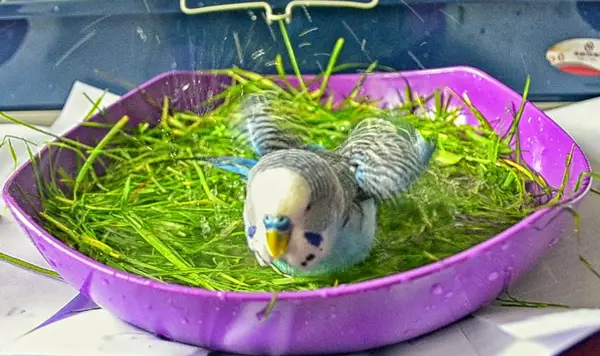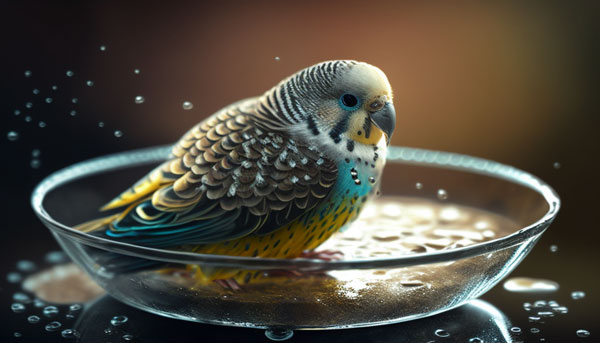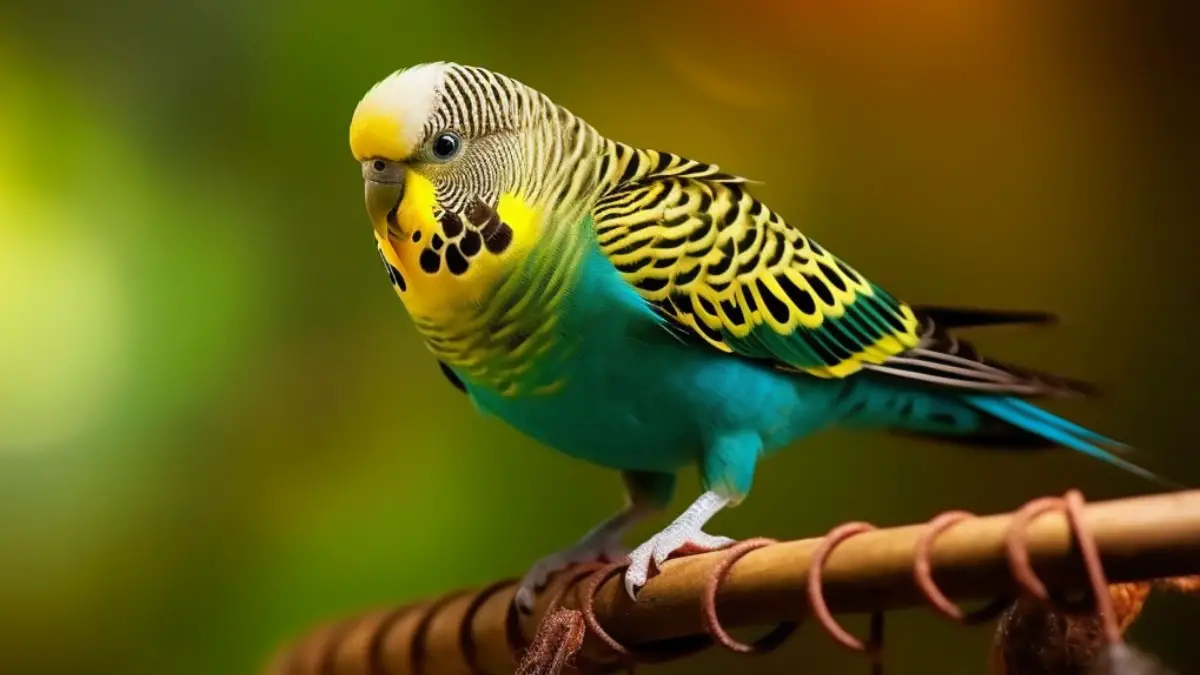Budgies in the wild and captivity enjoy preening their feathers. This behavior is a way of grooming to keep their plumage in the best condition by removing dirt and parasites.
But do budgies need a bath or is preening enough? Budgies require baths at least 2-3 times a week. Frequent baths help get rid of dirt and grime, ensuring healthy feathers. Bathing also helps remove potentially dangerous bacteria and parasites that could spread diseases. You can bathe your bird in a water bowl, bath fountain, or using a sprayer.
Since budgies need a bath, how do you clean and dry them? In this article, we will discuss everything there is to know about budgie bathing.
Do Budgies Need A Bath?
Yes, budgies do need a bath starting from when they are young. Bathing is crucial for your pet birds’ health as it helps keep dirt, bacteria, grime, and parasites away. Besides, other reasons budgies need a bath include:

Maintains healthy plumage
Bathing helps preserve the natural luster of your budgies’ plumage by keeping it free of dirt and grime. Simply, it helps keep their plumage shiny throughout.
Encourages preening
Before budgies take a bath, they must preen their feathers using their beaks. Preening is simply combing through their feathers to remove food debris, skin flakes, dust, parasites, and damaged feathers.

Moisturizes bird’s skin
Humans are not the only ones who may experience dry skin; even parakeets do. The skin of your budgies can become dry, itchy, and flaky, leading to feather plucking. Bathing your pet birds in room-temperature water can help moisturize their skin.

Removes pollutants
Budgie feathers are good at picking up pollutants, mainly when confined in poorly ventilated spaces. So, bathing helps eliminate dander and other contaminants your pet birds may ingest while preening.
Improves their mood
Bathing can be an enriching and entertaining experience for most parakeets. As a result, this helps keep your birds in good spirits and happy.

Regulating humidity levels
Budgies eggs require between 35 and 45% humidity during incubation. And during hatching, they need 65% or more humidity. So, bathing your pet birds during the breeding season allows them to regulate their nesting box’s humidity level.
While budgies need a bath, you don’t need to hand-bathe them unless they are sick or young. Bathing comes naturally to these pet birds. Therefore, the birds will bathe and groom themselves. You just ensure their budgie bath for cage has clean water.

But here is the thing; these parrot species prefer bathing in various ways. For example, these companion birds may bathe in the lake, on wet grasses, or under the rain shower in the wild. But in captivity, you can provide your birds with:
- Misting baths
- Cupping hands baths
- Fountain baths
- Basin or bowl baths
- Shower perches
How To Encourage Budgies To Bath?
Unfortunately, bathing does not come naturally for all budgies. So, you may have to entice your pet birds to shower, and here are tips on how to do it.

Also read: How Often Do Budgies Poop?
1. Try the misting method
You simply put lukewarm water in a spray bottle and spray it all over your bird’s plumage. Your birds will feel like they are bathing in the rain just as they do it in the wild.
2. Use a water bowl and favorite treat
Some parakeets don’t like being sprayed with water. In this case, you could use a bowl full of water instead. However, you must add some greens or their favorite treats in the bowl to encourage the birds to hop in.
Here is a video of several budgies taking a bath in a water bowl:
3. Hang wet greens in their cage
In the wild, budgies enjoy bathing in the wet grass. So, you could hang damp lettuce or other greens inside their cage to encourage your birds to shower. Alternatively, you can place the greens on a shallow plate and add some treats to entice them.
4. Add shower perches
You simply install a shower perch near your bathing shower. Your budgies will enjoy bathing as they watch you do the same.
5. Consider Tupperware with a mirror
After filling the Tupperware with water, you place a mirror inside at the bottom. Your budgies will be encouraged to shower because they think they are bathing with a companion.

6. Cupping hands under the sink
This method involves folding your palm into a curved shape under a slow-running sink faucet. Then, encourage your parakeets to fly over it using your other hand.
7. Invest in a flower fountain
Most birds will find a budgie bath fountain attractive because of the moving, falling, and splashing water. Consequently, this may motivate them to bathe.
How To Bathe a Parakeet?
Budgies do most of the work when it comes to bathing. You just provide them with clean lukewarm water. Below is a step-by-step guide on how to clean a parakeet.

Step 1: Fill a basin or bowl with water
First, get a shallow basin and fill it with lukewarm water. The water should be around two inches deep so your pet bird can stand on it without being entirely submerged.
Step 2: Set the bowl inside the cage
Next, place the bowl with water at the bottom of your parakeet’s cage and encourage your bird to hop in. Your pet birds will splash and flutter inside the water.
Step 3: Fill the sink with water
If your budgie does not like the budgie bath for cage, you can fill your sink with small amounts of water. Then, let your parakeet bath in the water.

Step 4: Get a spray bottle
Don’t have time for a complete bath? You can get a spray bottle and fill it with lukewarm water. Then, set the spray head to mist and spray the water over your parakeet’s plumage.
Step 5: Install shower perches
If your budgie does not like misting baths, you could install shower perches in your bathroom. As you shower, your parakeet can be splashed with water. Just ensure to put the perches farther from the direct water pressure from your bathroom’s showerhead, as it may hurt your bird.
Step 6: Dry off your bird
Once your pet bird is done cleaning itself, place it in a warm place free of cool breezes. Your parakeet will dry itself by shaking its feathers.
How To Dry a Budgie After A Bath
Budgies can dry themselves after each bath. However, there are several methods to dry your pet bird, including:

Sun drying
The easiest and fastest way to dry your budgie is to let it out in the sun. This is because, in the wild, these birds are used to air drying after a bath in the sun.
Use a small towel or cloth
You could use a small towel or cloth to dry your budgie if it is not sunny. You simply wrap the towel around your bird’s body but not tightly. Then, gently rub it on your pet’s plumage to soak away all the water.

Heat lamps
You can use heat lamps or infrared panels when you want to hasten the drying process. Besides helping dry your budgie after a bath, these lamps can also keep your bird warm.
Get a blow-dryer
Using this method, you must set the hairdryer at a low or warm temperature level instead of hot. More so, you should keep the dryer at a safe distance because a bird’s skin is hypersensitive.
How Often Should Budgies Bathe?
Most budgies love taking baths every day, which is okay. This is because it helps keep their plumage free from dirt and parasites. More so, it prevents their skin from drying up.

However, for birds that don’t like showering, you must ensure they take a bath at least 2 to 3 times a week. This is especially when your budgies are molting, as the water helps soothe their itchy skin.
Budgie Bath Water Temperature
The best temperature range for pet budgies is between 70- and 75 degrees Fahrenheit. Therefore, the water for bathing your pet birds should also be within this temperature range.

At 70-75-degree Fahrenheit, the water is considered to be room temperature or warm. You must avoid using too hot or cold water as it can shock your budgie’s system and even cause burns. Therefore, you must always check the temperature of the water using a thermometer.
Do Budgie Bath In Winter?
Yes. Budgies need to bathe in all seasons, including winter, to keep their plumage in good condition. However, your birds don’t need frequent baths during the winter compared to other seasons.
In addition, you must use a heater in your bird bath for parakeets to keep the water at room temperature. Alternatively, you could get an integrated heated bird bath.

Do Budgies Like Being Sprayed With Water?
Budgies love water in general. When it comes to being sprayed with water, many pet birds also enjoy it. In fact, some budgies will prefer the water spraying over showering in a basin filled with water.
However, some parakeets may be apprehensive about this bathing technique for the first time. When molting, most budgies like being sprayed with water occasionally. This is because the water helps soften their old feathers and eases shedding.
What Are The Do And Don’ts Of Bathing Budgies?
Giving your budgies a bath is essential. However, there are several do’s and don’ts to keep in mind while doing so, including:

- Only use plain water free from any cleaning agents such as chlorine.
- Always clean and sterilize your budgie bath fountain and change the water after every bath.
- Never use too hot or cold water because your birds can easily catch the flu or even suffer burns.
- Don’t use cleaning products like bird shampoos because they could strip your bird’s special oil.
- You should bathe your parakeets during the warmest of the day for ease of drying in the sun.
- You must never soak your budgie’s feathers entirely in water as it could lead to flight impairment or loss of body heat.
Related: Toys For Budgies
FAQs
Below are answers to frequently asked questions about budgies requiring a bath, including how to clean a parakeet.
Yes. Bird bath for parakeets are essential for their physical and emotional well-being. A good bath helps get rid of dirt from your budgie’s feathers. Consequently, this helps prevent parasites and bacteria infestation, reducing your bird’s risk of diseases.
Your budgie’s shaking after showering is quite normal and healthy. These pet birds usually shake their feathers and body to dry themselves. However, sometimes your bird may shake because of the cold, especially if you clean it with cold instead of lukewarm water.
Parakeets prefer warm water baths with temperatures between 70 and 75 degrees Fahrenheit. Cold water baths could shock your bird’s system. Besides, these pet birds are prone to colds.
Conclusion
Budgies require frequent baths, at least twice or thrice a week, even in the winter. But if your pet bird does not like showering, there are many ways to encourage it to bathe. The important thing is you ensure the bath water temperature is right. Moreover, you must watch out for the dos and don’ts of bird bath for parakeets.








